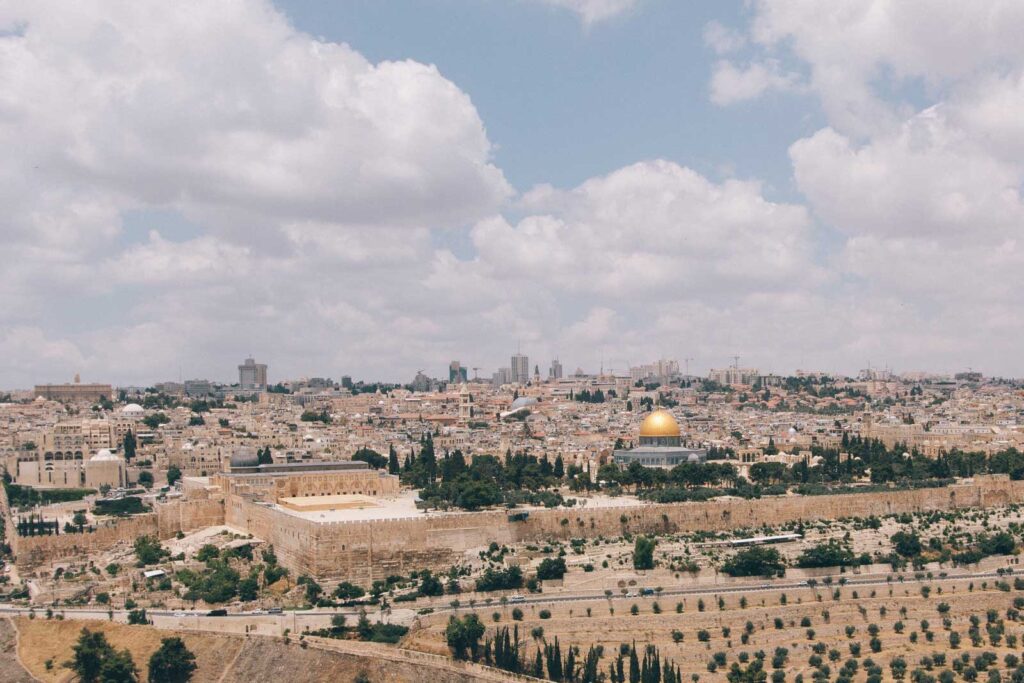The Abomination of Desolation
Jesus’ words in Matthew 24 are commonly referred to as the Olivet Discourse as He delivered this prophetic teaching to His disciples while sitting on the Mount of Olives overlooking Jerusalem. His address focuses on the “abomination of desolation,” an idea first found in the book of Daniel that speaks about the destruction of Jerusalem and the Temple (Daniel 9:24–27). Jesus reminded His audience of Daniel’s prophecy when He said, “Therefore when you see the abomination of desolation which was spoken of through Daniel the prophet, standing in the holy place (let the reader understand)” (Matthew 24:15).
Daniel’s prophecy was written about 539 bce. In Daniel 9:27, the angel Gabriel, while responding to Daniel’s prayer for the return of Israel from the Babylonian exile, said:
And he will make a firm covenant with the many for one week, but in the middle of the week he will put a stop to sacrifice and grain offering; and on the wing of abominations will come one who makes desolate, even until a complete destruction, one that is decreed, is poured out on the one who makes desolate.
The apostle Paul interpreted this abomination of desolation to be both a political and spiritual leader who will enter the Jerusalem Temple, declare himself to be God, and demand to be worshiped in the Temple as God:
Let no one in any way deceive you, for it will not come unless the apostasy comes first, and the man of lawlessness is revealed, the son of destruction, who opposes and exalts himself above every so-called god or object of worship, so that he takes his seat in the temple of God, displaying himself as being God.
(2 Thessalonians 2:3–4)
The Hanukkah story of Antiochus Epiphanes, who desecrated the Temple by erecting a statue of Zeus and by sacrificing swine on the altar, seemed to partially fulfill Daniel’s prophecy. However, Jesus, in the Olivet Discourse, makes it clear that Daniel’s prophecy of the abomination of desolation still awaits a future fulfillment.
The prophetic timeline of Daniel’s prophecy begins with the signing of a peace treaty between Israel and her neighbors brokered by the antichrist: “And he will make a firm covenant with the many for one week” (Daniel 9:27). That one week refers to the seventieth week of Daniel, a period of seven years that begins at the signing of the peace treaty.
The peace treaty might very well be the catalyst for a rebuilt Temple because Daniel’s prophecy continues with, “But in the middle of the week he will put a stop to sacrifice and grain offering” (Daniel 9:27). If, in the middle of the seven-year period, the antichrist halts sacrifice, the implication is the existence of a rebuilt Temple in which to offer sacrifices.
In the middle of the seventieth week of Daniel, at the midway point of three-and-a-half years, the antichrist will enter the rebuilt Temple in Jerusalem, declare Himself to be God, and demand to be worshiped as God. The antichrist is the abomination of desolation to whom Jesus referred. This act of desecration begins the second half of Daniel’s seventieth week, also called the “great tribulation” (Matthew 24:21) or the “time of Jacob’s distress” (Jeremiah 30:7). Jesus describes this time period: “For then there will be a great tribulation, such as has not occurred since the beginning of the world until now, nor ever will” (Matthew 24:21).
While the abomination of desolation and the tribulation sound frightening, Jesus reminds us that He will return shortly thereafter in a magnificent way: “And then the sign of the Son of Man will appear in the sky, and then all the tribes of the earth will mourn, and they will see the Son of Man coming on the clouds of the sky with power and great glory” (Matthew 24:30). God will establish His rightful kingdom, and the abomination of desolation—the antichrist—will find his end. Finally, according to the apostle John, writing in the book of Revelation, the devil will be eternally cast into the lake of fire at the conclusion of the millennial kingdom (Revelation 20:7–10).
Awaiting “That Day” (Zechariah 12:9–10)

In Zechariah 12:9–10, we read the phrase, “In that day” (בַּיּוֹם הַהוּא). It appears six times in chapter 12 alone. To understand Zechariah’s prophecy, the first question we must answer is: “In what day?” This section of Scripture, written hundreds of years before Jesus’ first coming, provides exciting insights into events that will occur at His second coming.
With the ongoing wars and attacks against Israel in the Middle East, a reasonable question is, “Are we getting closer to ‘that day’?” To understand the prophecy, we need to look at the preceding verses, 12:1–8. The context is a future time when all the nations will come against Israel and take part in a siege against Jerusalem.
“That day” may not be too far away considering the current world climate, which unfairly condemns Israel, and the growth of worldwide protests calling for the destruction of Israel and the Jewish people. For now, the United States stands with Israel, and we pray it will stay this way!
In the verses leading up to Zechariah 12:9–10, the nations will finally act out their true intent and attack Israel with overwhelming force. Yet, in that day, God will defend Israel from her enemies and give the Jewish people of Israel supernatural power and protection to defeat their enemies. The Lord Himself will defend the inhabitants of Jerusalem as “in that day I will set about to destroy all the nations that come against Jerusalem” (Zechariah 12:8–10).
Then the Jewish people will look upon Jesus and there will be a moment of national repentance, which brings about both physical and spiritual salvation:
I will pour out on the house of David and on the inhabitants of Jerusalem, the Spirit of grace and of supplication, so that they will look on Me whom they have pierced; and they will mourn for Him, as one mourns for an only son, and they will weep bitterly over Him like the bitter weeping over a firstborn. (Zechariah 12:10)
Reading this verse is enough to bring one to tears. When all seems lost, Jesus will put His feet on the Mount of Olives (see also Zechariah 14:4), reminding us who indeed is the all-powerful King and Savior.
The stage is set. Israel is in the Land and surrounded by enemies. We might not know the exact hour of Jesus’ return (Matthew 24:36), but we see the signs of the times lining up. It could be soon, so we need to live with the expectation that He could come at any moment. While we know there is a future time when the Jewish people will turn to Jesus, we pray that Jewish hearts will be open to the gospel today! As the apostle reminds us, we should not grow weary in sharing the good news as we eagerly await that great and glorious day (Galatians 6:9).
Ezekiel 37: Reviving the Dry Bones
The prophet Ezekiel lived during the Babylonian conquest of Israel in the mid-590s bce, between the first deportation in 604 bce and the second deportation in 586 bce. He wrote while he was in exile in Babylon. Chapters 36–39 are a vision of events yet to come from the perspective of captive Israel.
In chapter 37, Ezekiel presented the vision God showed him of a type of resurrection of Israel. God said to Ezekiel,
Prophesy over these bones and say to them, “O dry bones, hear the word of the Lord.” Thus says the Lord God to these bones, “Behold, I will cause breath to enter you that you may come to life. I will put sinews on you, make flesh grow back on you, cover you with skin and put breath in you that you may come alive; and you will know that I am the Lord.” (Ezekiel 37:4–6)
The vivid description of the prophecy makes it easy to imagine: a valley of dry bones that suddenly start to shake and rattle (Ezekiel 37:7). The reader can almost hear the sounds. The bones draw near to each other in the rattling, and the sinews begin to appear (Ezekiel 37:8). The Hebrew word for sinew means “a cord or band of inelastic tissue connecting a muscle with its bony attachment.”[1] In medical terms, this refers to ligaments and tendons, the tissue designed to hold the bones together.
Once the sinews appear, flesh grows. The Hebrew term for flesh refers to “the soft tissue of the body of a human being or animal: mainly muscle tissue and fat.”[2] The flesh is what lies under the skin and allows for movement and action. After the sinew and the flesh, skin grows to cover it all. The skin transforms the individual bones, sinews, and flesh into a singular organism. It allows all the parts to function together, united in purpose. Only once the skin is applied does the Lord send the breath so that the bones can live (Ezekiel 37:8–9).
Verses 11–14 explain the prophecy. The bones are the people of Israel in exile—hopeless and “cut off.” They will return to their land first; then God will send His life-giving Spirit. These words provide a glimpse of the timeline of the prophecy. But where are we now in the fulfillment of the resurrection of the dry bones?
If the fulfillment of the prophecy begins when the people of Israel return to their land, the birth of the State of Israel in 1948 sets the stage. When Israel became a nation again, it boasted a population of only 806,000 people.[3] According to The Jewish Agency, at the end of 2023, there were 7.2 million Jewish people in Israel,[4] which is almost nine times the number of Jewish people living there at the re-settling of the country. The bones are back, ready to be spiritually revived through God’s Spirit, just as the prophecy predicted.
Over the years, little by little, the bones grew closer together. Every battle, every existential threat against the Jewish people wove sinew among the bones, giving them structure that began holding them together. But it was just the start.
There was a spiritual sound made on October 7, 2023—the sound of the dry bones rattling. The massacre awakened something in Israelis and in Jewish people around the world that held prophetic significance. The bones started coming together and staying together. Muscles formed and people started taking action. Skin appeared, and Israelis began acting as one against those who would see the Jewish people wiped from the earth and against antisemitism and hatred around the globe. Jewish people started bonding as a people, returning to their Jewish identity and to their land. God used this tragedy to further Israel’s awakening.
Today, Israel still suffers from divisions politically, religiously, and in a number of other ways. All the more reason to pray for the peace of Jerusalem (Psalm 122:6) and the unity of the Jewish people—especially in Israel.
All that is left is for God’s breath of life to come upon the Jewish people, and the prophecy will be fulfilled. There is an inscription at the entrance to Yad Vashem, the Holocaust Remembrance Center in Jerusalem. It is written in Hebrew, but the English translation is:
“I will put My Spirit within you and you will come to life, and I will place you on your own land,” (Ezekiel 37:14).
In that day, Paul’s prophecy will also come to pass, and “all Israel will be saved” (Romans 11:26) as the Jewish people turn to Jesus the Messiah. May that day come soon!
[1] Rick Brannan, ed., Lexham Research Lexicon of the Hebrew Bible, Lexham Research Lexicons (Bellingham, WA: Lexham Press, 2020), s.v. גִּיד.
[2] Brannan, s.v. בָּשָׂר.
[3] “Israel’s Demography Has a Unique History,” PRB (Population Reference Bureau), January 9, 2014, https://www.prb.org/resources/israels-demography-has-a-unique-history/.
[4] “Jewish Population Rises to 15.7 Million Worldwide in 2023,” The Jewish Agency for Israel – U.S., September 19, 2023, https://www.jewishagency.org/jewish-population-rises-to-15-7-million-worldwide-in-2023/.

Sign up to receive our email newsletters
Get the latest news from Israel, insights from Dr. Mitch Glaser, international ministry reports, as well as videos and podcasts, downloadable resources, discounts in our online store, and much more!
